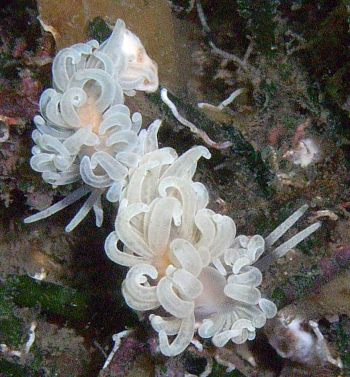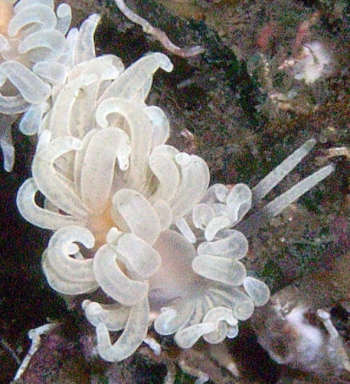Phyllodesmium serratum ? from Tasmania
May 3, 2006
From: Robin Thomson

Simpson's Point, Tasmani is a great spot for finding nudibranchs. Its a patch of boulders, rich with sea whips and sponges, in the middle of a vast area of bare mud and scallop beds. We always find 4 or 5 different nudi species on every dive there. This is where my dive buddy and I recently found these 2 white nudis canoodling. Although the photo doesn't show it clearly, each animal had two distinct pairs of 'antennae'. Our best guess is that they are Phyllodesmium serratum but there was no white stripe down the back. There also seems to be a bewildering amount of variation in the Phyllodesmium. We decided to turn to the guru for enlightenment.
I'd also like to take this opportunity to say thanks very much for Sea Slug Forum. It's a wonderful resource. I'd probably be less interested in nudis if it wasn't for this well-compiled, accessible, information.
Locality: Simpson's Point, D'entrecasteaux channel, Hobart, 9.0 m, Tasmania, Australia, Southern ocean, 29 April 2006, Reef: rocks and mud. Length: 13 mm. Photographer: Mitchell Rolls.
Robin Thomson
robin.thomson@csiro.au
Thomson, R.B., 2006 (May 3) Phyllodesmium serratum ? from Tasmania. [Message in] Sea Slug Forum. Australian Museum, Sydney. Available from http://www.seaslugforum.net/find/16499
Dear Robin,
Despite the lack of a median white line I am pretty sure this is P. serratum. For a long time I tried to find some anatomical differences in the various colour forms of this species in south-eastern Australia and then I found specimens in Darwin which are apparently the same thing, indistingusihable from animals from Japan. I suppose in the future, DNA studies could show that what we are calling 'P. serratum' is a group of cryptic species, but at present there doesn't seem to be any anatomical characters to separate them. At one stage I was toying with the idea of defining species on the basis of their food, as P. serratum in New South Wales normally feeds on the telestacean soft-coral Carijoa sp. while in Tasmania I have found it on the stoloniferan Clavularia sp. I dropped this idea when I found aquarium juveniles in Darwin destroying a colony of the gorgonian Junceela, although their parents had been collected on the alcyonacean Steronephthya, suggesting that this species feeds on a much wider range of octocorals than other species in the genus.
Best wishes,
Bill Rudman
Related messages
-
Re: Phyllodesmium serratum from Port Phillip Bay, Victoria
From: Andy Barton, February 11, 2009 -
Phyllodesmium serratum from Port Phillip Bay, Victoria
From: Marc Saunders, October 10, 2005 -
Phyllodesmium serratum from Japan
From: Yukari Sato, February 10, 2004 -
Re: Phyllodesmium serratum from Mornington Penins.
From: Bill Rudman, January 26, 1999
